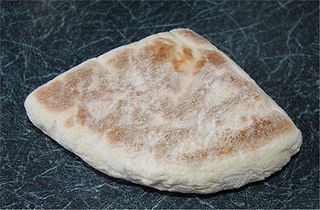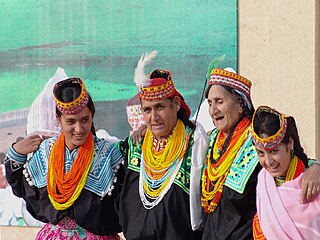Related Research Articles

Bread is a staple food prepared from a dough of flour and water, usually by baking. Throughout recorded history and around the world, it has been an important part of many cultures' diet. It is one of the oldest human-made foods, having been of significance since the dawn of agriculture, and plays an essential role in both religious rituals and secular culture.

Pastry is baked food made with a dough of flour, water and shortening that may be savoury or sweetened. Sweetened pastries are often described as bakers' confectionery. The word "pastries" suggests many kinds of baked products made from ingredients such as flour, sugar, milk, butter, shortening, baking powder, and eggs. Small tarts and other sweet baked products are called pastries as a synecdoche. Common pastry dishes include pies, tarts, quiches, croissants, and pasties.

Cornbread is a quick bread made with cornmeal, associated with the cuisine of the Southern United States, with origins in Native American cuisine. It is an example of batter bread. Dumplings and pancakes made with finely ground cornmeal are staple foods of the Hopi people in Arizona. The Hidatsa people of the Upper Midwest call baked cornbread naktsi. Cherokee and Seneca tribes enrich the basic batter, adding chestnuts, sunflower seeds, apples or berries, and sometimes combining beans or potatoes with the cornmeal. Modern versions of cornbread are usually leavened by baking powder.

Dough is a thick, malleable, sometimes elastic paste made from grains or from leguminous or chestnut crops. Dough is typically made by mixing flour with a small amount of water or other liquid and sometimes includes yeast or other leavening agents, as well as ingredients such as fats or flavorings.

Soda bread is a variety of quick bread traditionally made in a variety of cuisines in which sodium bicarbonate is used as a leavening agent instead of the traditional yeast. The ingredients of traditional soda bread are flour, baking soda, salt, and buttermilk. The buttermilk in the dough contains lactic acid, which reacts with the baking soda to form tiny bubbles of carbon dioxide. Other ingredients can be added, such as butter, egg, raisins, or nuts. An advantage of quick breads is their ability to be prepared quickly and reliably, without requiring the time-consuming skilled labor and temperature control needed for traditional yeast breads.

Damper is a thick homemade soda bread traditionally prepared by early European settlers in Australia. The bread is different from bush bread, which has been made by Indigenous Australians for thousands of years and was traditionally made by crushing a variety of native seeds, nuts and roots, mixing them into a dough, and then baking the dough in the coals of a fire. There is ongoing investigation into whether this technique of various Aboriginal peoples influenced the development of colonial-era damper, similarly cooked in the ashes of a camp fire.

Boxty is a traditional Irish potato pancake. The dish is mostly associated with the north midlands, north Connacht and southern Ulster, in particular the counties of Leitrim, Mayo, Sligo, Donegal, Fermanagh, Longford, and Cavan. There are many recipes but all contain finely grated, raw potatoes and all are served fried.

A flatbread is a bread made with flour; water, milk, yogurt, or other liquid; and salt, and then thoroughly rolled into flattened dough. Many flatbreads are unleavened, although some are leavened, such as pizza and pita bread.

Indian breads are a wide variety of flatbreads and crêpes which are an integral part of Indian cuisine. Their variation reflects the diversity of Indian culture and food habits.

Johnnycake, also known as journey cake, johnny bread, hoecake, shawnee cake or spider cornbread, is a cornmeal flatbread, a type of batter bread. An early American staple food, it is prepared on the Atlantic coast from Newfoundland to Jamaica. The food originates from the indigenous people of North America. It is still eaten in the West Indies, Dominican Republic, Saint Croix, The Bahamas, Colombia, Bermuda, Curaçao and Puerto Rico as well as in the United States and Canada.

Vienna bread is a type of bread that is produced from a process developed in Vienna, Austria, in the 19th century. The Vienna process used high milling of Hungarian grain, and cereal press-yeast for leavening.

Bammy is a traditional Jamaican cassava flatbread descended from the simple flatbread eaten by the Arawaks, Jamaica's original inhabitants. Today, it is produced in many rural communities and sold in stores and by street vendors in Jamaica and abroad.

A flour tortilla or wheat tortilla is a type of soft, thin flatbread made from finely ground wheat flour. It was originally inspired by the corn tortilla of Mexican cuisine, a flatbread of maize which predates the arrival of Europeans to the Americas. Made with a flour- and water-based dough, it is pressed and cooked, similar to corn tortillas. The simplest recipes use only flour, water, fat, and salt, but commercially-made flour tortillas generally contain chemical leavening agents such as baking powder, and other ingredients.

A great variety of cassava-based dishes are consumed in the regions where cassava is cultivated, and the ingredient is included many national or ethnic specialities.

Nordic bread culture has existed in Denmark, Finland, Norway, and Sweden from prehistoric times through to the present. It is often characterized by the usage of rye flour, barley flour, a mixture of nuts, seeds, and herbs, and varying densities depending on the region. Often, bread is served as an accompaniment to various recipes and meals. Nordic breads are often seasoned with an assortment of different spices and additives, such as caraway seeds, orange zest, anisa, and honey.

Taguella is a flat bread, the staple dish of Tuareg people living in the Sahara. It is a disk-shaped bread made from wheat flour and cooked buried underneath the hot sand and charcoal of a small fire. The bread is then broken up into small pieces and eaten with a meat sauce.

Kalash cuisine consists of indigenous dishes as well as many local Pakistani cuisine influences. Foodstuffs such as apricots, grapes, mulberries, walnuts and wheat are grown in the Kalash valleys.

Ash cake is a type of bread baked over a layer of heated stones or sand and covered-over in hot ashes, a practice still found principally in Arabian countries, especially among Bedouins.
References
- 1 2 "How to make firecakes." George Washington's Mount Vernon. Retrieved June 21, 2021.
- 1 2 "Firecake Recipe." Historic Valley Forge. Retrieved June 21, 2021.
- 1 2 Army Logistician 8 (1976) 1, p. 27.
- ↑ Risch, Erna (1981). Supplying Washington's Army. Center of Military History, p. 195.